From the late seventeenth to the mid-twentieth century sulphur mining was flourishing in Chile. One of the most important sulphur deposits was found on the flank of Tacora volcano, the northernmost Chilean volcano, lying hard on the triple border with Peru and Bolivia. Sulphur mining on active volcanoes has been compared to hell on multiple occasions. In Chile, the miners not only had to deal with toxic gases and hard labour conditions, but also with the high altitude (>5000 m a.s.l.) and sub-zero temperatures. At Tacora, the sulphur was loaded and transported directly on a branch of the former Arica-La Paz steam-engine train line. This railway was the world's highest, with sections higher than 4800m a.s.l.
The old steam engine train from Tacora loaded with sulphur. Image taken from Memoria de Ferrocarriles del Estado de 1970. More information on this train line at: http://www.institutoferroviario.cl/2014/07/la-industria-azufrera-el-andarivel-y-el-ferrocarril-de-tacora/
Today, sulphur is produced as a by-product by the oil and gas industry and traditional sulphur mining is close to extinction worldwide. Ghost towns, abandoned railways, and spoil tip are the only remaining traces of this once booming industry in the Altiplano. Conveniently for us, half washed-away roads and dirt tracks up active volcanoes are also part of this legacy.
Compared to the work of miners, our work on the flank of the same volcano forty years later is a walk in the park! We take temperature readings to find the hottest fumaroles for our gas measurements. While the fumaroles are hot and toxic, our gas masks and Supertrousers keep us well protected. The one thing we share with the miners, however, is that we are constantly bathed in brimstone. After more than a month on volcanoes, everything - our clothes, our equipment, our skin - is impregnated by the smell of sulphur. We often wrap up a hard day of work with a soak in a nearby hot spring -- but this doesn't seem to do much to wash away the volcanic perfume.
An active fumarole on Tacora seen in the infrared and visible







